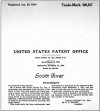- Joined
- Jan 27, 2007
- Messages
- 6,518
I bought a Case #6217 Loomfixer (two-blade Jack, basically a large Swayback handle shape) from a member here a while back; I'm trying to figure out where the name "Loomfixer" came from. Anyone know?  It's a fantastic carver/whittler - great spoon carver.
It's a fantastic carver/whittler - great spoon carver.
The history, as I know it, is that this pattern was introduced in the 1930's or 40's, had several scale materials over the years (mine is laminated wood) and ended production sometime in the 70's. (Not sure on the end-of-production date.)
So, anyone have any idea why it's called a "Loomfixer", and not a "Large Swayback", or simply a "Large [two-blade] Jack"?
~Chris
The history, as I know it, is that this pattern was introduced in the 1930's or 40's, had several scale materials over the years (mine is laminated wood) and ended production sometime in the 70's. (Not sure on the end-of-production date.)
So, anyone have any idea why it's called a "Loomfixer", and not a "Large Swayback", or simply a "Large [two-blade] Jack"?
~Chris



